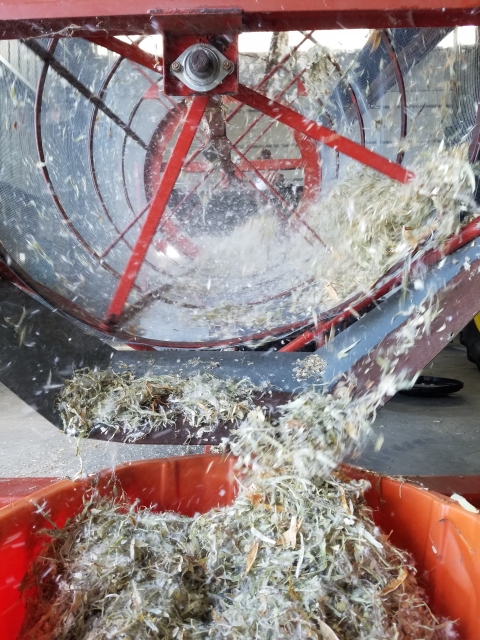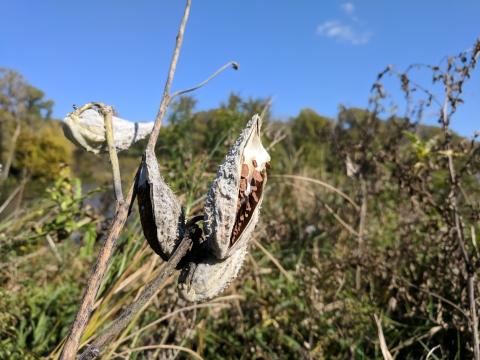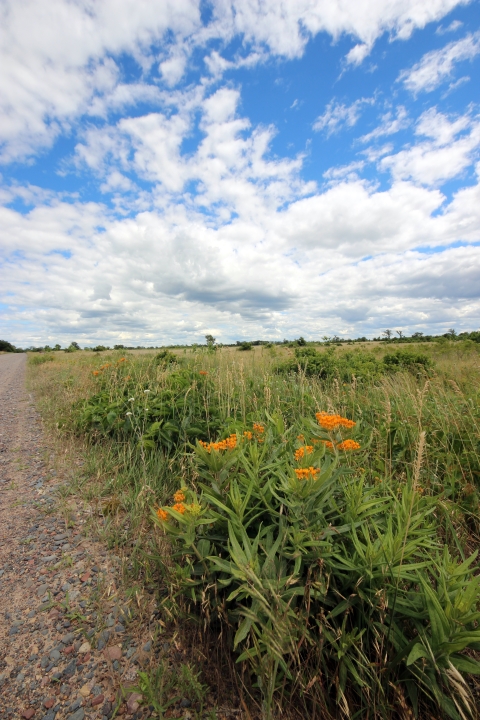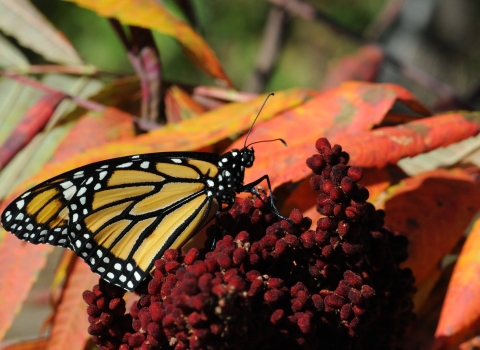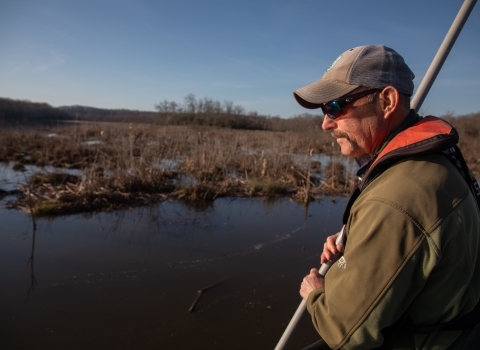The monarch is more than one butterfly. Think of it as an ambassador to a mosaic of prairie plants and animals that all need soil, sun and time to grow. In the face of massive habitat loss, we at the U.S. Fish and Wildlife Service have been making a home for monarchs and species of the wider prairie ecosystem for decades. Now you can too in your own backyard.
Our prairie restoration is intentional. Like a doctor fixing a sick patient, the way to health is to nurture the patient over time. Our prescription to improve health, called a habitat management plan, varies depending on the site. Factors that contribute to the plan include a plant survey to see what is already growing on the site, soil samples and drainage. Once we have the information, plants are selected to best improve the prairie’s health. This is something that you can do, even if you live in the city and have only a small curbside boulevard. If you use the right plants, you can attract monarchs to your backyard, providing an essential migration path.
Monarchs migrate more than 3,000 miles to Oyamel fir forests located in the mountains of central Mexico. Containing plenty of blooming flowers, prairie habitat is needed across their migratory path in the United States to fuel their journey south in the fall. Lesser known, and even more imperiled insects, like the Poweshiek skipperling and the Dakota skipper quietly benefit through these actions as well.
Prairie restoration is a year-round effort, even in the cold, dark winter. We wanted to offer you a snapshot of what we are doing this time of year on some of our national wildlife refuges and wetland management districts to get ready for the growing season. You can adapt these steps for your own backyard.
In simple terms, building habitat for monarchs and other prairie species is all about the seed.
- Getting the right seed
- Drying and storing seed
- Spreading the seed
- Knowing when to mow
Getting the right seed
Across the country, there are more than 100 different types of milkweed, and even more nectar plants to choose from, but not all will do well in your part of the country. Selecting the right combination of milkweed and nectar plants for your area is essential.
Milkweed and other forbs are not universal and we go to great lengths to use seed from specific geographies that mirror remnant prairie. State and federal land managers all work together to coordinate seed harvest efforts on prairies. Regardless of partner ownership, potential harvest sites are prioritized based on species diversity which allows vendors to be more efficient in their harvest. As a result, all partners have access to high quality seed grown locally for use in their prairie restorations.
Case in point, Detroit Lakes Wetland Management District in northwestern Minnesota oversees management of the entire process. They have been building prairie habitat for more than 20 years by harvesting a diverse seed mix from places like Santee Prairie State Natural Area to restore former cropland.
Using a typical agricultural combine, district staff harvest, dry and store native seed each fall for planting in late February and into March. Staff test a sample batch of this harvest each year to get a sense of how viable the seed is, as well as what sort of plant diversity they have in the mix. It is key to have a mix of early and late-blooming nectar plants, as well as milkweed, to provide food sources over the course of the growing season. Over several years, these samples have had as much as 60 different native prairie plants, which bodes well for healthy prairies. The majority of these samples have had various milkweed species.
As a result of this work, the cooperative harvests an average of 30,000 pounds of bulk seed from 8-10 sites per year. Since 2016, this has been enough seed to restore more than 3,500 acres of native grasslands.
While seed sources on most federal and state lands are not available for the public to harvest, you can learn a lot by talking with your local national wildlife refuge national wildlife refuge
A national wildlife refuge is typically a contiguous area of land and water managed by the U.S. Fish and Wildlife Service for the conservation and, where appropriate, restoration of fish, wildlife and plant resources and their habitats for the benefit of present and future generations of Americans.
Learn more about national wildlife refuge and wetland management district wetland management district
A wetland management district is a U.S. Fish and Wildlife Service office that manages waterfowl production areas in one or more counties. Waterfowl production areas are small natural wetlands and grasslands that provide breeding, resting and nesting habitat for waterfowl, shorebirds, grassland birds and other wildlife. The Fish and Wildlife Service acquires waterfowl production areas under the authority of the Migratory Bird Hunting and Conservation Stamp Act, primarily using funds from the sale of Federal Duck Stamps. The Refuge System’s 38 wetland management districts comprise thousands of waterfowl production areas – almost all in the Prairie Pothole Region of the Northern Great Plains.
Learn more about wetland management district staff. To get started, contact your local, reputable garden nursery to learn more about the milkweed and nectar plants that are right for your geographic area.
Drying and storing seed
Whether your seed harvest operation is high-volume, like Detroit Lakes, or in your own garden, drying and storing seed is an important step in advancing prairie habitat the following spring. Start drying your seed immediately after you harvest. In the case of the Detroit Lakes operation, the drying process takes about a week in the fall for each round of plants harvested. Large fans and a series of aeration tubes help staff dry seeds as quickly as possible so the seeds do not rot.
After the seed is dry, bag and store it in a covered, cold place where it will stay dry throughout the winter months. Most species require a minimum of 30 days of cold storage to prepare for spreading in the early spring. At Detroit Lakes, staff keep seed at cold outdoor temperatures for roughly four to five months.
Spreading the seed
Late winter is a great time to spread milkweed seeds because when you are restoring an area that does not have prairie plants, you need to add them to the land in a way that anchors them and gives them a chance to germinate before the snow melts or wildlife eats them.
The best weather scenario for planting is a blanket of snow and late winter sun. Staff at Detroit Lakes look for one to two feet of snow on the ground before spreading seed if possible. The angle of the sun is an important aspect of planting because as the sun’s light hits the dark seed, the heat causes the seeds to melt down into the snow during the day and then freeze into place once air temperatures lower at night. When there is not enough snow, staff use large rollers to anchor them to bare ground.
If you want to allow for natural stratification, sow collected seeds directly into a mulched bed in the fall and the seeds will germinate the following spring.
Knowing when to mow
Each piece of prairie has a unique climate and is impacted by invasive plants and management practices from neighboring landowners. In the earlier example of Detroit Lakes, we find that the best way to manage prairie is through an annual cycle of spring prescribed burning, followed by a late summer seed collection. Letting the native plants move through their full growing cycle is the best tool against encroaching invasives like eastern red cedar trees that can turn a prairie into a forest or spotted knapweed which kills surrounding plants, allowing the unwanted plant to spread quickly.
As Detroit Lakes project leader Ryan Frohling explains, “We don’t mow very much, only when we get a serious weed complaint. We have worked with the counties to inform them about the diversity of species that we have.”
“Not only grass, but the forbs and wildflowers, will out-compete invasives such as plumeless thistle. What we’ve found, is that after about three years we no longer have any issues with this invasive, because the native plants out-compete them,” continued Frohling.
The monarch’s success or peril is a gauge of the overall health of a whole suite of life here in the midwest. When we work for monarch conservation on protected lands and when you mindfully welcome them to your gardens across the region during migration, we know that we are all supporting prairie health.


